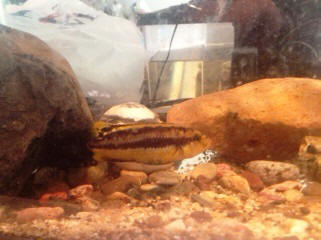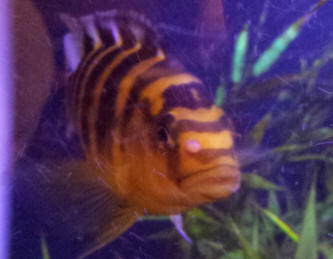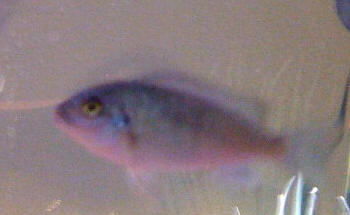|
FAQs on Pseudotropheus Cichlids
Related Articles: Jewel
Cichlids, Dwarf South American
Cichlids, Discus, Juraparoids, Neotropical Cichlids, African Cichlids, Asian Cichlids, Cichlid Fishes in General,
Related FAQs: Cichlids of the World, Cichlid Systems, Cichlid Identification, Cichlid Behavior, Cichlid Compatibility, Cichlid Selection, Cichlid Feeding, Cichlid Disease, Cichlid
Reproduction,
|

|
|
White cyst - like bump on cichlids nostril
7/5/14
Dear WWM Crew,
We have been in the fish business for about 1.5 years. The question I
have pertains to our 120 gallon cichlid tank. We have 22 cichlids from
Lakes Victoria, Malawi, and Tanganyika. Some of our fish are 6 inches
all the way down to 1 inch. We check our water every week or 2 and we do
10-20% water change every week. Currently, our water tests perfect in
every category. It has been the same for the last 2 months (prior to
that it was cycling). We just purchased a 6 inch bumblebee
(Pseudotropheus crabro) 2
weeks ago. It has been acting fine and feeding well. All of our other
fish appear themselves and very normal. Three days ago I noticed a white
pimple/cyst on its right nostril. It has grown a bit since then. It is
about twice the size of an O. I am unsure of what to do. I don't like
using medicines, but of course I will if that is what he needs. I have
researched and could not find any descriptions or pictures that matched
our
bumblebees situation. I would really appreciate your advice and I thank
you so much for your time.
Sincerely,
Allison
<Looks like an infected nostril, with a prolapse or similar causing
internal tissue to expand outwards. May clear up in time, but I would
definitely treat with an antibacterial or antibiotic (don't forget to
remove carbon, if used) as per Finrot. The use of Epsom salt at 3
teaspoons per 5 US gallons/20 litres would be beneficial. Have bcc'ed
our resident cichlid expert, Chuck, to see if he can chime in here.
Cheers, Neale.>
|
 |
|
Re: White cyst - like bump on cichlids nostril
7/5/14
Neale,
Thank you so much for responding! We will get him into our hospital tank
and begin treatments. What medication do you recommend?
<Whatever's sold in your area that's good for Finrot would be a good
first choice. Seachem Kanaplex or the old favourite Maracyn 1 + 2
combination are two options. Basically, avoid the "natural" (read:
unreliable) treatments such as Tea-Tree Oil. On the other hand, using
Epsom salt often helps reducing swelling, and a modest addition of sea
salt can be beneficial to cichlids if they're under the weather a bit,
though don't go nuts, a teaspoon or two per gallon is ample.>
He's a lovely fish and we don't want to lose him. Thank you again.
<Most welcome, Neale.>
Sincerely,
Allison
White cyst - like bump on cichlids nostril
/Chuck's go
7/7/14
White Bumps On Cichlid's Nose
Dear WWM Crew,
We have been in the fish business for about 1.5 years. The question I
have pertains to our 120 gallon cichlid tank. We have 22 cichlids from
Lakes Victoria, Malawi, and Tanganyika. Some
of our fish are 6 inches all the way down to 1
inch. We check our water every week or 2 and we do 10-20%
water change every week. Currently, our water tests perfect in
every category. It has been the same for the
last 2 months (prior to that it was cycling). We just purchased a 6 inch
bumblebee (Pseudotropheus crabro)
2 weeks ago. It has been acting fine and
feeding well. All of our other fish appear
themselves and very normal. Three days ago I noticed a white
pimple/cyst on its right nostril. It has grown a bit since then.
It is
about twice the size of an O. I am unsure of what to do. I don't like
using medicines, but of course I will if that is what he needs. I
have researched and could not find any
descriptions or pictures that matched our bumblebees situation. I would
really appreciate your advice and I thank you
so much for your time. Sincerely, Allison Hicks
< You crabro has an infection in its sinus cavity. Sometimes cichlids
dive into the sand and gravel sifting for food and a small particle of
the substrate gets lodged in the sinus cavity. This particle can
irritate the
lining causing and infection even after the particle becomes dislodged.
The infection seals off the sinus cavity and no circulation comes
through making it difficult to treat. This infection may work its way to
the surface where it can be treated. At one inch it is going to be
difficult to really clean the area. I would recommend placing the fish
in a small hospital tank and treating with a Nitrofuranace (Furan-2)
type of compound. It has any bacterial and anti-fungal
properties.-Chuck>
|
My Auratus Cichlid is sick 3/23/14
Hello,
<Sarah>
My female auratus cichlid seems to be struggling to
survive. She is in the tank with a male
auratus who has been harassing her
attempting to mate but she doesn’t seem
interested. She spends all her time getting
away from him and is now completely exhausted. She lays in corners
hiding and only stirs if i walk up to the tank. I’ve noticed over the
past few days that she has stopped eating, and
has stopped pooping, and that area has become swollen
and red.
<These fish need to be separated. Now>
I’m wondering if there's
anything I can do to make her better? There are 3 other cichlids in the
tank and 4 zebra danios. The cichlids eat Omega One Cichlid pellets
and the danios eat flakes. All the levels in
the tank are healthy, I do regular water changes (once a week, about
50%) and it’s a 45 gallon tank. Please
help! And thank you so much for your time!
Sarah
<Let's have you read here:
http://wetwebmedia.com/FWSubWebIndex/afcichdisf8.htm
and the linked files above. Bob Fenner>
Re: My Auratus Cichlid is sick 3/24/14
Thank you so much for responding so quickly! I have temporarily elevated
her in a large net in the same tank so none of the other fish can get at
her, she's resting and in the past couple hours she seems to be feeling
a bit better.
<Good>
I don't have a proper hospital tank and everything is closed for the
evening. what would be the smallest safe size of container I could put
her in until I can get to the store in the morning?
I don't think I can leave her in the net.
<A floating plastic colander... READ where you were referred. B>
|
Auratus
10/5/13
I recently rescued an Auratus female from an LFS who was just going to
put her down because she was born without a tail. She swims just fine.
Maybe a lil bouncy lol. But fine none the less.
<No worries>
Her color is my main concern. She was a dark dark brown (no
white at all) when I brought her home. Her color has since turned more
golden and she is getting a pretty shiny mask. But she still
isn't anything like all the other Auratus I have seen
Is this something to worry about
<Ah no. Your female Auratus is turning into a male... a natural course
of events. Bob Fenner>
|
 |
Re: Auratus
10/5/13
Really? That's amazing. I'm open minded. No problems raising transgender
fishes. Lol.
<... just protogynic synchronous hermaphroditic...>
She is in a tank with our kribensis fry. She/he had always herded em around
and whatnot like they were hers. As one or two get big and start being mean
she keeps them away from the little ones till I move them out. We really are
in love with this little fish. I guess I only have one question then....
I've heard of a single fish having babies by itself. That isn't something
this fish will be capable of is it?
<Not this species... but there are others. Search the words: "Amazon
Molly"... be prepared to have your mind blown>
(maybe a dumb ??? But I'm curious)
Thanks
<Cheers, BobF> |
|
Cichlid Two-Part Question, "Assorted/mixed
Pseudotropheus", traits, undesirability of
hybrids 11/18/09
Hello,
<Hello,>
I have two questions, and any information that can be given would
be so very much appreciated.
<Fire away.>
Firstly, I bought four freshwater cichlids from Petco, and
I'd like to figure out exactly what type of cichlids they
are. The only name given at the store was "Small African
Cichlid," and the clerks at the store don't know
anything more than that (they don't really know much at all),
none of them are specialists. I've attached a picture to show
you what the fish kind of look like.
<Without an actual photo of *your* cichlid it's really
difficult to answer questions like this. There are 2000 cichlid
species to choose from, and many of them are very
similar!>
Mine don't have those spots nor striped fins, their tail fins
are more translucent, there isn't a variation in color
(except for what I mention below), and they're not quite as
iridescent. *BUT* the shape of the body and the face is exactly
like that. The fins are very similar, but a little different.
There isn't a bulge a the end of the top fin like there is on
the fish in the picture.
<What you have is almost certainly some type of Pseudotropheus
hybrid.
These are very commonly traded by the less responsible pet
stores. Being hybrids, you can predict virtually nothing about
them with any certainty.
But at a guess, they're most likely to become fairly big
(around 15 cm), be extremely aggressive (not community fish at
all), nippy (will damage slow moving tankmates) and be more or
less omnivorous (needing a diet that contains both plant and
animal foods). Colours will likely not match anything in any
books you have. Muddy blues and yellows tend to be commonest.
I've said it before and I'll say it again: never buy a
Malawian cichlid not specifically sold under a Latin
name.>
Here are the physical details I can give you that might help you
distinguish. You'll have to excuse me if I don't know
most of the terminology. -- The fish are each mostly one color
(no spots), a couple have a slight vertical fade of their color
-- from the top to the underbelly (the top being darker than the
underbelly). Of these cichlids, I have one that is a light blue,
an orange, a yellow, and a salmon colored one that is more
red-ish on top and more of a pale pink on the underbelly. Their
tail fins are flared out *a bit* like a triangle, but the edges
are rounded off. None of their fins are extravagant, flowy, nor
long.
This is all the information I have for you, unless you have some
questions that I'd be able to answer. They're the
cheapest cichlids in Petco (if you happen to go in there often,
or ever...not that I'm asking you to go to the lengths making
a trip to Petco or anything).
<The "cheapest cichlids" is the clue. Nobody wants
them. The only people who buy them are inexperienced fishkeepers,
who quickly learn that these fish are worthless. Hybrids are a
curse on the hobby, and the reason why so many Malawian cichlid
aquaria don't have the bright, vivacious colours you see in
magazines (where wild-caught, or at least pure-bred, species are
used).>
*The second part* to this is, if you do know what kind I have, is
there a way to tell their sex without venting them? Is there some
other distinguishing characteristic(s) or behavior that might
give me a good idea of the fish's sex?
<Males are generally slightly bigger, much (MUCH!) more
aggressive, and usually, but not always, have more yellow spots
on their anal fins. Females can have yellow spots, though rarely
many, and often none at all. Wild and pure-bred species often
have quite strong differences in colouration, but these will be
weak or absent in the case of hybrids.>
I know all of this is very long, vague and probably not possible
to answer, but if you have any ideas I would be very, very
grateful. I've done hours of research online trying to figure
out what kind I have, but I've got nothing.
<As will be the case with hybrids.>
Thank you in advance for any help.
<My pleasure.>
Sincerely,
Ariel M.
<Cheers, Neale.>
Re: Cichlid Two-Part Question
11/18/09
I am such an idiot. I should have done that in the first place.
D'oh! >_<
There are some pictures of mine attached (hardest pictures to
take, ever).
And you're right about the aggression, well at least for one
of them (the biggest one). It's awful to the other fish. I
only have the same cichlids in there, but he(?) bullies all of
the other fish and hogs all the food.
<Certainly Pseudotropheus "something". Likely
hybrids. But do check out things like Pseudotropheus zebra and
Pseudotropheus saulosi, among other things, as these are
particularly commonly traded. Adult Pseudotropheus zebra (and
indeed some hybrids) are incredibly aggressive, and males can,
will kill off any fish in the tank they consider rivals. Minimum
tank size for these "big" Pseudotropheus species (and
hybrids) is 55 gallons because of this. Not "easy" fish
by any stretch of the imagination. Cheers, Neale.>
|
[1]%20mix%20cich.jpg) [1]%20mix%20cich.jpg)  |
Re: Cichlid Two-Part
Question
How long does it take for them to become fully grown?
<About 6-12 months.>
The biggest one is only about an inch and a quarter right now.
<He's just a baby, and already causing problems... Cheers,
Neale.> |
|
|

